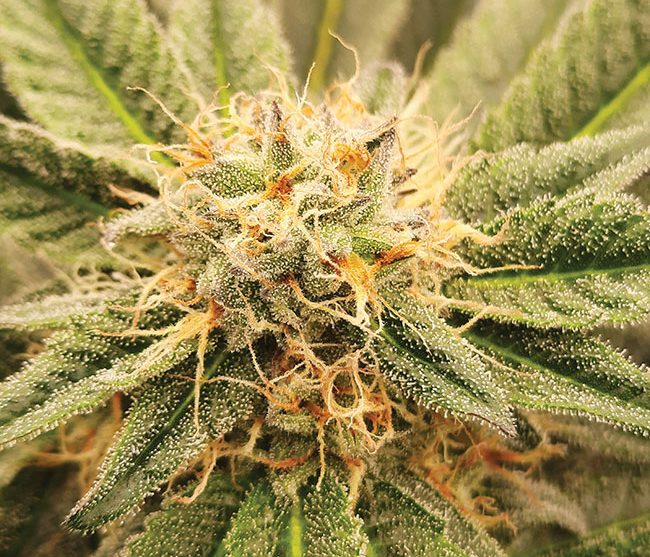
Features
Cultivation
Production
Cultivation: Quality post-harvest practices for cannabis
September 19, 2022 By Mohyuddin Mirza

Undeniably, growing cannabis is a tedious yet rewarding process. All cannabis crop management practices affect the post-harvest quality, which determines the product outcome. Post-harvest quality parameters will also vary with the end use of the cannabis flower. One of the most important aspects of growing quality cannabis comes when you are ready to harvest your plant.
When is the best time to harvest?
The image (above) shows an example of a ripe bud where pistils have turned amber in colour and trichomes are no longer translucent. The number of days in flower will vary by strain. Typically, indica plants will be ready for harvest in approximately 50 to 60 days, and sativa usually between 60 and 70 days.
Harvesting plants too early or too late can affect potency and yield, potentially lessening the flower’s quality. The number of days from flower to harvest will also influence the way plants are grown, vegetatively or generatively.
Should growers harvest fresh buds or hang branches to dry?
Growers follow three main practices while gathering buds for drying and processing:
- Harvest the entire plant and hang it up, then harvest the buds when they’re dry.
- Remove the branches with the buds intact, hang them and then harvest the buds after drying.
- Remove the buds from the stem to save space, and dry buds in boxes or on trays.
When the entire plant is hung up, usually it takes longer to dry. During handling, the dried leaves and buds may fall or crumble.
Processing your cannabis buds
Drying: Several factors such as microbial activity, moisture content, room temperature, and duration of light, affect the post-harvest quality and sustainability of cannabis. Drying is the most effective technique for controlling microbial activity and enabling long-term storage while maintaining potency, taste, and medicinal properties.
Several drying methods have been used to dry the flowers, including hot air drying, oven drying, vacuum freeze-drying, atmospheric freeze-drying, and microwave-assisted drying.
While carrying out the drying process, keep the following points in mind:
- If you are drying the entire plant, then ensure that everything is set up prior to harvest — racks are properly placed and disinfected in advance;
- Don’t overcrowd the drying rooms. Keep the dry rooms well-ventilated with proper air flow to maintain ideal temperatures and humidity levels, which decreases the chances of mould and mildew;
- Some growers use higher temperatures for the first three to five days to get rid of moisture quickly, and then drop to lower temperatures;
- We recommend using Vapor Pressure Deficit (VPD) as a guideline rather than temperature and humidity independently. VPD indicates the difference of water activity inside the buds as compared to outside of them;
- A good range for proper loss of water from buds is suggested to be between seven to nine millibars. Temperature and RH adjusted to achieve proper VPD will help to avoid condensation and mould;
- Measuring the moisture content of cannabis buds determines the effectiveness of drying and curing techniques, which also affect the terpene concentration and chemical profile of the finished product;
- The moisture content of adequately cured cannabis flower should be less than 13 per cent.
Curing: Curing is essentially a process of “ripening the buds” where dried buds are placed into airtight containers and stored in a dark environment between 15.5 to 20 degrees, with around 60 per cent humidity. Measuring water activity (aW) in cannabis buds helps determine how vulnerable the product is to microbial contamination. Mitigating water activity reduces the chance of microbial growth and allows the product to be stored for extended periods.
Growers often mistakenly assume that higher moisture content in the flower means a higher water activity but that’s not always correct. It is possible to have low moisture content in the product and still have water activity that is more than 0.65 aW. It is recommended that dried cannabis be stored in sealed containers with water activity below 0.65aW.
Storing the product with poor drying conditions under high humidity encourages the formation of microbial spores and harmful microbial toxins such as aflatoxin, as well as powdery mildew and botrytis, which causes the deterioration of cannabis.
The therapeutic potential of cannabis products depends heavily on the initial quality of the plant material, as influenced by the harvesting time, harvesting technique, and post-harvesting technologies. This also helps to determine the chemical composition and quality of the buds.
Safety has been the biggest concern, however, since no proper standardised procedures are present, it’s difficult to enforce. Thus, having controlled processing systems in place, in alignment with the scientific evidence, is essential.
Dr. Mohyuddin Mirza, PhD, is an industry consultant in Edmonton, Alta. He can be reached at drmirzaconsultants@gmail.com.
Gagandeep Singh Bhatoa is a scientific writer in Regina, Sask. He can be reached at gaganagrico@gmailcom.
Print this page